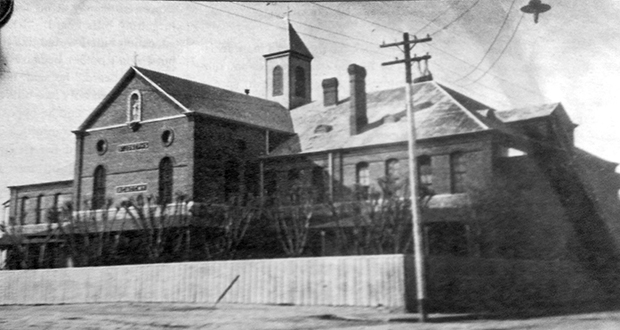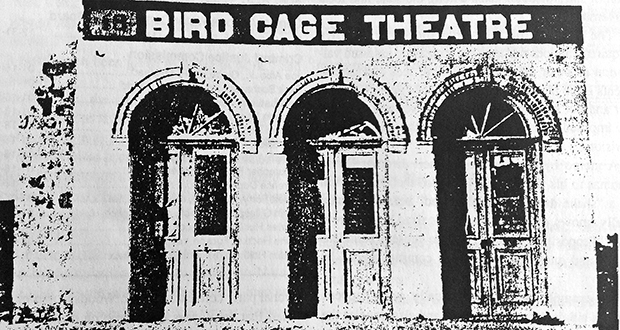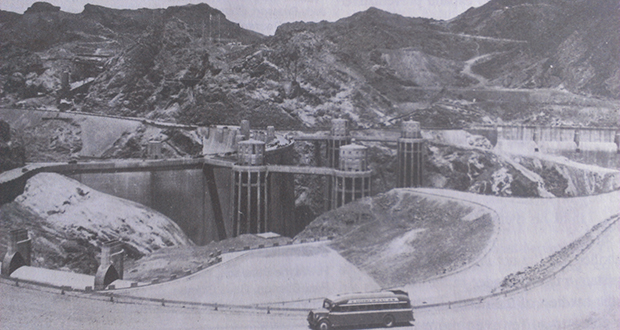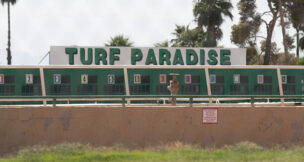San Carlos Apache Reservation
Despite its stark appearance, the U.S. Indian Agency at the San Carlos Apache Reservation was a marked improvement over the “…log hut with an earthen floor and canvas doors” that served as headquarters when John P. Clum, newly appointed agent, arrived on the reservation on Aug. 8, 1874.
First Catholic School in the Territory
The original St. Joseph’s Academy (called the Convent School) was established in 1868 adjacent to Tucson’s old St. Augustine Cathedral. It was a thick-walled adobe building, built in the “fashion of the country’’ with earthen floors and a roof of sagebrush and cactus interfaced on pine rafters and covered with mud.
Old Nogales City Hall
Nogales City Hall was commissioned by the Nogales Volunteer Fire Department in 1914, opened in 1915, and served as Town Hall and later City Hall for 65 years.
Steamboats on the Colorado
Impressive as the steamboat Gila appears, Martha Summerhays, an Army wife who journeyed on the boat in 1874, described the steamer in less than glorious terms: “We had staterooms, but could not remain in them long on account of the intense heat. After a hasty meal and a few remarks upon the salt beef and the general misery of our lot, we could seek some spot which might be a trifle cooler. Conve[...]
The Gouldings of Monument Valley
Harry Goulding was born in Durango, Colorado, in 1897. He was from a family of sheepmen, and he ran sheep in Colorado and New Mexico as a youth. He talked his way into the Army in World War I, being underage, and ended up as a mule sergeant in the 7th Engineers. After his discharge he headed back west to find a spot where he “could look a hundred miles in any direction and not see a second lieut[...]
Tombstone’s Bird Cage Theatre
In its heyday between 1881 and 1889, the Bird Cage – replete with wallpaper imported from Paris, massive grand piano, orchestra pit, box seats and well-stocked bar – was the most famous honky-tonk in America.
Hoover Dam Construction
It took five years – from 1931 to 1936 – to build the Hoover Dam, what was then the largest concrete dam in the world. It was built in the Black Canyon of the Colorado River, in northwestern Arizona on the border with Nevada.
Wyatt Earp’s Last Years
When Earp abandoned Tombstone in 1882, several months after the bloody shootout at the OK Corral, he left behind a sullied reputation that contrasts remarkably with his later image as an American folk hero, and spent the remainder of his life battling what he called “the slings and arrows of outrageous fortune’’ brought about by “bad press.’’
Phoenix YMCA
The YMCA was founded in Phoenix in 1892. Its mission was to provide a safe haven for the many young men drawn to the frontier. At the time Phoenix was wide open for gambling, drinking and other such pursuits. The Y was part of a growing evangelical Christian movement intended to save the souls of young men cut loose from home and family. It was different from other religious organizations in that [...]
Museum at the Petrified Forest
Early explorers of the area who arrived prior to the railroad in the 1850s described in their reports an area of barren hillsides strewn with colorful stone longs, the remains of trees that once stood in a prehistoric tropical forest.
Sedona to Flagstaff Through Oak Creek
The road from Sedona through Oak Creek Canyon to Flagstaff, Arizona’s scenic Highway 89A, was just a patchwork of private tracks until the first part of the 20th century.
The Hanging of Dennis Dilda
In the 1880s, Dennis Dilda had left behind a string of murders in Texas and New Mexico by the time he arrived in Prescott in the fall of 1885. But in the frontier, little was asked of a man’s background, especially one with a wife and children. Dilda soon got a job running the ranch of W.H. Williscraft about 40 miles outside of town.












































